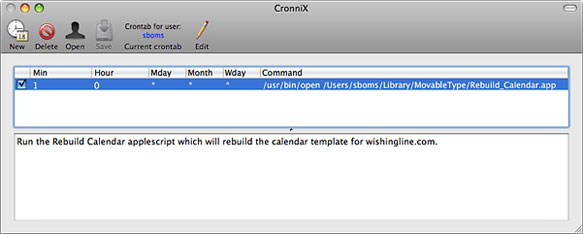During the process of making some of the small design and features changes that have seen the light of day on this site, I split out the sidebar calendar widget into its own include file. The Movable Type manual suggests this as a way of reducing the processing required during rebuilds of the index templates. Makes sense. Why do something more than once if you don’t have to.
One of the other things that made the cut was a complete refactoring of the actual HTML for the calendar since it was unnecessarily bloated. This was a good opportunity to play with the CSS a bit and give the calendar a bit more visual flair.
The thing I want to point out is that there’s a single TD element with an ID applied, indicating the current date. I made this change/addition but then realized that it’s not practical if I don’t post every day or I don’t rebuild the template every day to have the ID change positions appropriately.
Given that I’m currently using static publishing through Movable Type, I needed a way to automatically rebuild this template daily and ideally without me needing to remember to actually do it myself. Due to limitations at my host, I discovered that my options for automating this were limited so I rolled my own solution using a bit of AppleScript and a cron job on my main development system which stays on pretty much all the time.
Turn On System Events Scriptability
For this to work, you first need to turn on the option for “Enable Accessibility for Assistive Devices” in the Universal Access preferences in Mac OS X which allows you to target menus and execute keyboard commands programatically using AppleScript. Essentially this allows you to make just about anything scriptable whether an application supports it natively with a built-in scripting dictionary or not.

How It Works
The general rundown of how the script works is this - the script launches via cron, opens a specified URL (the path to the Movable Type rebuild script along with the template ID) which, once loaded, causes the button on the page to be clicked using an accesskey which then rebuilds the template at which point the script closes. Sounds simple right? There was one snafu along the way, but luckily it was easy to resolve.
That one snafu? I had to modify one of Movable Type’s internal templates (specifically /tmpl/cms/rebuild_confirm.tmpl) to add the necessary accesskey which would allow the script to programatically press the button causing the template to be rebuilt. Not having the accesskey meant that there was no mechanism to actually press the button on the page.
The script then, when running and after the page has fully loaded (checked using do JavaScript( document.readyState = "complete" )) uses the keystroke command to execute the keyboard command for the accesskey. In this case set to Control-S in the template.
I had a tough time sorting out exactly how to format the keystroke command (lousy AppleScript docs…), but for future reference and anyone else struggling it is:
tell application “System Events” to keystroke “s” using {control down}
I was missing the tell statement. It was late when I was working on this part so I’ll blame it on being tired…
Making It Run
Mac OS X, being a Unix-based OS includes the cron scheduling utility. cron is used in the system to run a series of regular tasks for doing things like cleaning up and archiving log files but is really a general-purpose scheduling utility and a perfect fit for what was needed here to automate running this script. To add the task to the schedule, it’s simply a matter of editing your crontab file and adding the new command. In this case, I set it to run every day at 12:01 AM.

Note that you may want to prepend the command with /usr/bin/open in order to actually open the application bundle (the AppleScript) via the shell. This shouldn’t be necessary since the path is already included in the default Mac OS X shell environment, but it’s probably good form just in case.
The crontab file can be edited by typing crontab -e in the Terminal or you can use a GUI application such as CronniX which is a bit easier and also makes testing things easy. If everything works, you’re good to go.
A (Minor) Caveat
One minor caveat to all this is that you need to have saved your Movable Type administration login information so the browser can access it without intervention. This means in your System Keychain. I don’t recommend running something like this on a public computer, but in a secured environment (e.g. home computer behind a firewall), you should be sufficiently safe.
Code Download
You can download a generic version of the script via the link below.
Rebuild Movable Type Template AppleScript - 5 KB (.sit file)
So say you…
Very, very cool.
I won’t claim to be an AppleScript expert or anything, and there’s likely a lot of room for improvement, but it’s good enough for the time being.
Rome wasn’t built in a day… (not that my measly script is Rome or anything…)